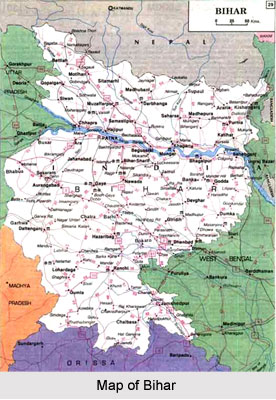 Division of Bihar was made during the time of British regime and remained a part of the Bengal Presidency till 1912. The mutiny had brought about certain stringent administrative measures. Like other parts of India, the liberals and the loyalists of the latter half of the 19th Century Bihar fought their ends through constitutional means. The first paper to come out in Bihar proper was the "Bihar Herald" in 1874. This paper came under the control of one of the leading lawyers, Sri Guru Prasad Sena. In 1882 Sri Harvansa Sahay of Arrah for the first time was nominated to the Bengal Legislative Council. He was later succeeded by Rai Bahadur Jay-Pralash Lail C. I. E., the Dewan of Dumraon. Late Sir Bisheshwar Singh was another great leader of the time. The other leading personalities of the time were Rai Bahadur Gajadhar Prasad, a member of the Bengal Legislative Council, Mr. Mahesh Narain, Sharfuddin, Khan Bahadur Syed Fazal Imam, Sri Tej Narain Singh, Maharaj Lakshmeswara Singh, Rai Bahadur Fasmeshuar Narain Mahta and Sri Sachidanand Sinha.
Division of Bihar was made during the time of British regime and remained a part of the Bengal Presidency till 1912. The mutiny had brought about certain stringent administrative measures. Like other parts of India, the liberals and the loyalists of the latter half of the 19th Century Bihar fought their ends through constitutional means. The first paper to come out in Bihar proper was the "Bihar Herald" in 1874. This paper came under the control of one of the leading lawyers, Sri Guru Prasad Sena. In 1882 Sri Harvansa Sahay of Arrah for the first time was nominated to the Bengal Legislative Council. He was later succeeded by Rai Bahadur Jay-Pralash Lail C. I. E., the Dewan of Dumraon. Late Sir Bisheshwar Singh was another great leader of the time. The other leading personalities of the time were Rai Bahadur Gajadhar Prasad, a member of the Bengal Legislative Council, Mr. Mahesh Narain, Sharfuddin, Khan Bahadur Syed Fazal Imam, Sri Tej Narain Singh, Maharaj Lakshmeswara Singh, Rai Bahadur Fasmeshuar Narain Mahta and Sri Sachidanand Sinha.
It is said that with the birth of this paper began the renaissance in Bihar. In 1907, the paper was renamed `Behari` and it became a daily after 1912. It was the greatest exponent of public opinion and was edited by Mr. Mahesh Narain.
By the year 1894, the Government of India had begun to think for the transfer of Chittagong Commissionership to Assam administration. This aroused enthusiasm among the Biharis and public meetings were held and the demand of separation gained ground. The movement alarmed the Bengal administration. The Pioneer of Allahabad also supported the creation of a separate Bihar Province. These agitations brought the question in the forefront of the then politics. Thus the movement took a new shape. The leaders began educating the public opinion. In 1906 Sri Mahesh Narayan and Dr. Sachidanand Sinha brought out a booklet entitled, `The Partition of Bengal or Separation of Bihar` which was largely circulated in England and India. The book educated the public opinion in India and especially in Bengal and Bihar.
In 1905, the Secretary of State sanctioned the partition of Bengal. The aim of the British Government was to crush the rising revolutionary movement in Bengal. According to this plan, west Bengal and Bihar formed one province and East Bengal and Assam formed another. Partition of Bengal became an accomplished fact and after that Lord Curzon left India. In 1906, Sir Andrew Frazer, the Lieutenant Governor of New Bengal, acquired Chajju-bagh house for his new residence.
Sharfuddin was appointed a judge of Calcutta High Court. In 1908, the first Bihar Provincial Conference was held at Patna under the President ship of Ali Imam. In that the appointment of` Ali Imam as a law member was rejoiced. On December 12, 1911, the King Emperor at Delhi announced the creation of Bihar and Orissa as a separate province with Patna as the capital. Bihar thus obtained a distinct individuality in 1912. In 1916 the new High Court of Patna was opened by Lord Hardinge and in the following year Patna University was established. Thus the separation of Bihar became an accomplished fact. In 1935-36 Orissa was made a separate province with Cuttack as its Capital.



















